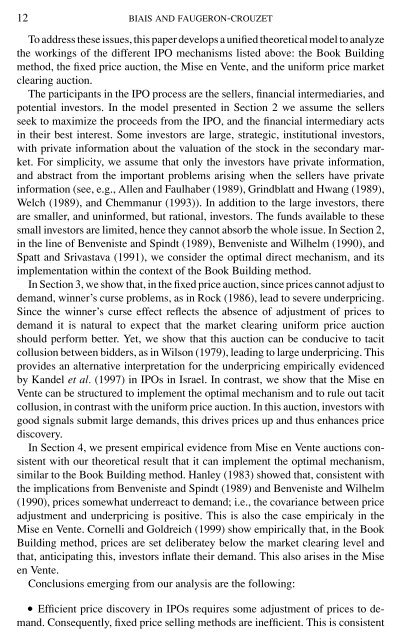IPO Auctions: English, Dutch, ... French, and Internet
IPO Auctions: English, Dutch, ... French, and Internet
IPO Auctions: English, Dutch, ... French, and Internet
You also want an ePaper? Increase the reach of your titles
YUMPU automatically turns print PDFs into web optimized ePapers that Google loves.
12 BIAIS AND FAUGERON-CROUZET<br />
To address these issues, this paper develops a unified theoretical model to analyze<br />
the workings of the different <strong>IPO</strong> mechanisms listed above: the Book Building<br />
method, the fixed price auction, the Mise en Vente, <strong>and</strong> the uniform price market<br />
clearing auction.<br />
The participants in the <strong>IPO</strong> process are the sellers, financial intermediaries, <strong>and</strong><br />
potential investors. In the model presented in Section 2 we assume the sellers<br />
seek to maximize the proceeds from the <strong>IPO</strong>, <strong>and</strong> the financial intermediary acts<br />
in their best interest. Some investors are large, strategic, institutional investors,<br />
with private information about the valuation of the stock in the secondary market.<br />
For simplicity, we assume that only the investors have private information,<br />
<strong>and</strong> abstract from the important problems arising when the sellers have private<br />
information (see, e.g., Allen <strong>and</strong> Faulhaber (1989), Grindblatt <strong>and</strong> Hwang (1989),<br />
Welch (1989), <strong>and</strong> Chemmanur (1993)). In addition to the large investors, there<br />
are smaller, <strong>and</strong> uninformed, but rational, investors. The funds available to these<br />
small investors are limited, hence they cannot absorb the whole issue. In Section 2,<br />
in the line of Benveniste <strong>and</strong> Spindt (1989), Benveniste <strong>and</strong> Wilhelm (1990), <strong>and</strong><br />
Spatt <strong>and</strong> Srivastava (1991), we consider the optimal direct mechanism, <strong>and</strong> its<br />
implementation within the context of the Book Building method.<br />
In Section 3, we show that, in the fixed price auction, since prices cannot adjust to<br />
dem<strong>and</strong>, winner’s curse problems, as in Rock (1986), lead to severe underpricing.<br />
Since the winner’s curse effect reflects the absence of adjustment of prices to<br />
dem<strong>and</strong> it is natural to expect that the market clearing uniform price auction<br />
should perform better. Yet, we show that this auction can be conducive to tacit<br />
collusion between bidders, as in Wilson (1979), leading to large underpricing. This<br />
provides an alternative interpretation for the underpricing empirically evidenced<br />
by K<strong>and</strong>el et al. (1997) in <strong>IPO</strong>s in Israel. In contrast, we show that the Mise en<br />
Vente can be structured to implement the optimal mechanism <strong>and</strong> to rule out tacit<br />
collusion, in contrast with the uniform price auction. In this auction, investors with<br />
good signals submit large dem<strong>and</strong>s, this drives prices up <strong>and</strong> thus enhances price<br />
discovery.<br />
In Section 4, we present empirical evidence from Mise en Vente auctions consistent<br />
with our theoretical result that it can implement the optimal mechanism,<br />
similar to the Book Building method. Hanley (1983) showed that, consistent with<br />
the implications from Benveniste <strong>and</strong> Spindt (1989) <strong>and</strong> Benveniste <strong>and</strong> Wilhelm<br />
(1990), prices somewhat underreact to dem<strong>and</strong>; i.e., the covariance between price<br />
adjustment <strong>and</strong> underpricing is positive. This is also the case empiricaly in the<br />
Mise en Vente. Cornelli <strong>and</strong> Goldreich (1999) show empirically that, in the Book<br />
Building method, prices are set deliberatey below the market clearing level <strong>and</strong><br />
that, anticipating this, investors inflate their dem<strong>and</strong>. This also arises in the Mise<br />
en Vente.<br />
Conclusions emerging from our analysis are the following:<br />
• Efficient price discovery in <strong>IPO</strong>s requires some adjustment of prices to dem<strong>and</strong>.<br />
Consequently, fixed price selling methods are inefficient. This is consistent
















